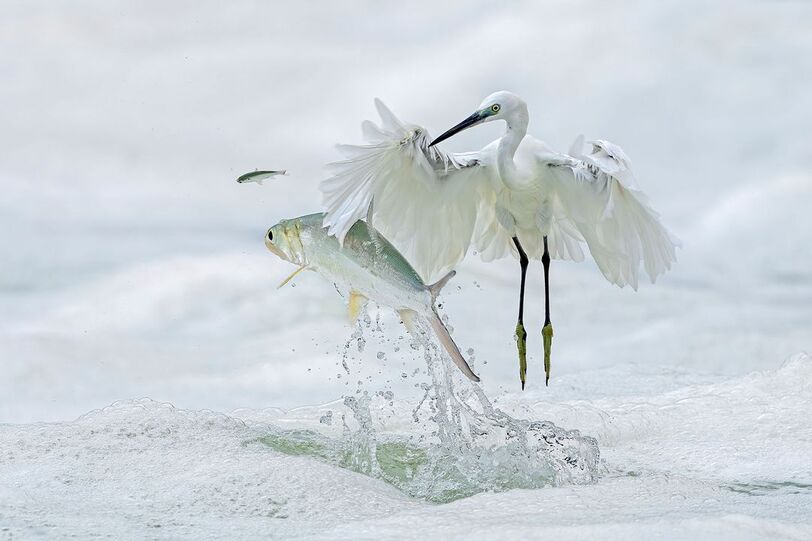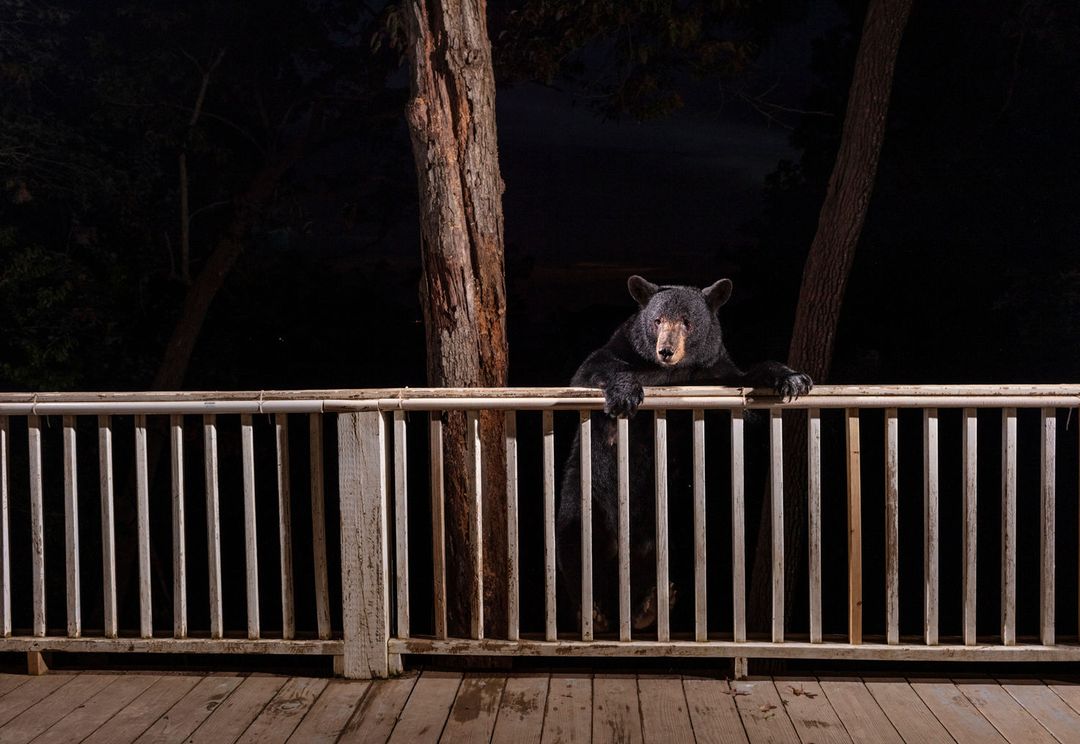
Academy of Science's Photo Exhibit Showcases That Decisive Moment
By David Boitano
"BigPicture" Celebrates 10th Anniversary and Publishes New Book Featuring Award-winning Female Wildlife Photographers
A good wildlife photograph tells a story, moves the viewer emotionally or motivates a person to take action. Photographs containing all of the above are on display at the California Academy of Sciences in celebration of the 2023 “BigPicture: Natural World Photography” exhibit.
Now in its 10th year, the world-wide competition invites nature photographers to submit works in a variety of categories based on capturing the essence of the natural world.
Over the past decade, the contest has attracted more than 64,000 submissions and awarded more than $120,000 in prize money. This year’s competition attracted 7,300 entries from professional and amateur photographers.
“Taken together, they offer a rich history of the biodiversity of our planet,” said neuroscientist Indre Viskontas who brought a new dimension to the display this year. “What is unique about Big Picture is how it combines sciences and art,” she said. “The macro of the environment and the micro of how the photographer got that painstaking shot. Our scientists provide the context and the photographers explain what makes an extraordinary photograph, all presented in a model exhibit,” she added.
During a multi-media show within the academy’s Morrison Planetarium, Viskontas showed exactly how a dramatic photograph can effect a viewer’s thinking and perception. Electrodes attached to the brain of former academy photographer Susan Middleton, displayed a multi-color moving readout streamed across the planetarium dome. Each color represented one of three brain networks involved in perception. Middleton was then asked to describe her impressions of the first place art as follows:

"Pass By" by Lin Xiaoping, Xiamen, China. Winner of "Winged Life" category: An egret catches a fish while the prey is pursuing its own aquatic meal.
“This is a perfect example of what Henri Cartier-Bresson calls a decisive moment,” she said. “The level of difficulty astounds me, because the photographer basically froze time in exactly the right second. That requires a kind of magic intuitive sense that is really miraculous.”

"For Survival" by Donglin Zhou, Hangzhou, China. "Terrestrial Wildlife" category: A snow leopard bears down on a female Pallas cat while she tries to catch rodents for her kittens. The cat was killed, but the kittens survived with help from local residents.
“The dramatic tension in this image is so powerful,” Middleton said. “You know when you are looking what’s going to happen, but it’s that apprehension and gesture of both of these animals, freezing time in exactly the right instance that creates an image that is so perfect.”

"Nose to Nose" by Douglas Gimesy, Brighton, Victoria, Australia. Winner in the "Human/Nature" category: an Australian veterinary student nuzzles with a baby wombat whose mother was hit and killed by a car.
“I can feel the fragility, but also the hope in the loving human that cares for him,” Middleton said. While eliciting viewer’s emotions, good wildlife art can also move people to action, Viskontas said.
“Even when the images are distressing, we can feel motivated to do something to help,” she said. “The academy’s mission to preserve and protect the natural world reminds us that we share the Earth with countless other species but we have proven to be poor caretakers.”
The exhibit, containing many more photographs, continues in the academy’s piazza area.
Memorable photos by some of the women who judged or won the BigPicture competition are featured in a new book, “Seeing It All: Women Photographers Expose Our Planet.”
The book, by the academy’s Creative Director Rhonda Rubenstein, features 125 photographs and a forward by renowned marine biologist Sylvia Earle.
Tracking urban animals led to award winning photo

"Backyard Friend (from Cities Gone Wild)" by Corey Arnold, Washington, U.S.
The offer made to photographer Corey Arnold by the National Geographic was the job of a lifetime: photograph wild animals living in the nation’s cities to determine if they were smarter and bolder than their country cousins.
But to illustrate his subject, Arnold first had to find the elusive beasts. “To learn the nightly world of wildlife I had to become an animal detective,” he said. “I crawled through fence holes, pondered endless piles of scat and spent many an autumn night waiting for a bear to crawl out of a basement. It was not the average photo assignment.”
But Arnold’s hard worked paid off in the form of “Cities Gone Wild,” a photo essay in the July 2022 edition of the National Geographic magazine. One of the shots, “Backyard Friend,” was the 2023 Grand Prize winner in the annual California Academy of Sciences “Big Picture" competition.
Arnold is a Washington state commercial fisherman and photographer who has had a lifelong fascination with wild animals. His images have been featured in the New York Times, Rolling Stone, Smithsonian and other publications.
While traversing the world on various magazine assignments, Arnold enjoyed the random interactions he often had with wildlife. He was a natural for this kind of assignment.
Tracking the raccoons, coyotes and black bears that now call urban areas home would take him across the nation from San Francisco to Chicago and finally rural North Carolina.
He would search for the best bestial hangouts by posting a request on Instagram for suggestions in each city he was visiting. In Chicago an ecologist helped him track coyotes.
“By following radio collars, I learned that stealth is their best asset,” he said. “They are good at preventing detection and they don’t violate other coyote’s areas.”
San Francisco was a special haunt for raccoons and most of his nocturnal subjects were conveniently found in Golden Gate Park, not far from where he was honored by the academy on October 5.
Others found their way into houses and roofs. A raccoon’s natural abilities pay off when trying to find a good place to stay, Arnold said. “Raccoons are uniquely designed to adapt to the human environment,” he said. “With dexterous hands, they are able to open latches and squeeze into unimaginably tight spaces.”
Residents of South Lake Tahoe often end up with a bear as an unwelcome border in basements and other out-of-the way places. A strong supply of household garbage keeps the animals active year round, when they should be hibernating during winter.
But it was in Ashville, North Carolina that the human-bear connection reached its apex.
There are so many bears, in fact, that the residents name them and sometimes treat them as pets. “I was kind of shocked,” Arnold said. “When I told people what I was doing, everyone would whip out their phones and show the bears they had captured on a cell phone.”
One couple’s home was in a kind of bear migration corridor, and the homeowners had photos of the critters regularly frolicking on their deck. Arnold set up a camera trap to get a good shot. After days of getting shots of other animals and human neighbors, the camera produced the perfect winning image: a big adult bear climbing the fence, sporting a no-nonsense “I’m-here-to get-what-I want” expression.
Despite being appealing and photogenic, bears are wild animals and Ashville’s townspeople should learn to keep their distance, Arnold observed.
“Everyone has a close encounter story and I was surprised how habituated the bears were,” he said. “They (humans) have been very lucky so far. Scientists working on an urban-suburban bear study say it’s just a matter of time before they get way too close to the bears.”
The jury’s still out on whether the city animals are smarter, but Arnold’s photography shows that some may have adjusted to an urban lifestyle.
“We are finally seeing them for what they are,” he said. “Extremely complex highly social animals that are more adaptable then we realized.”
BigPicture: Natural World Photography is on view at the California Academy of Sciences until April 7, 2024



